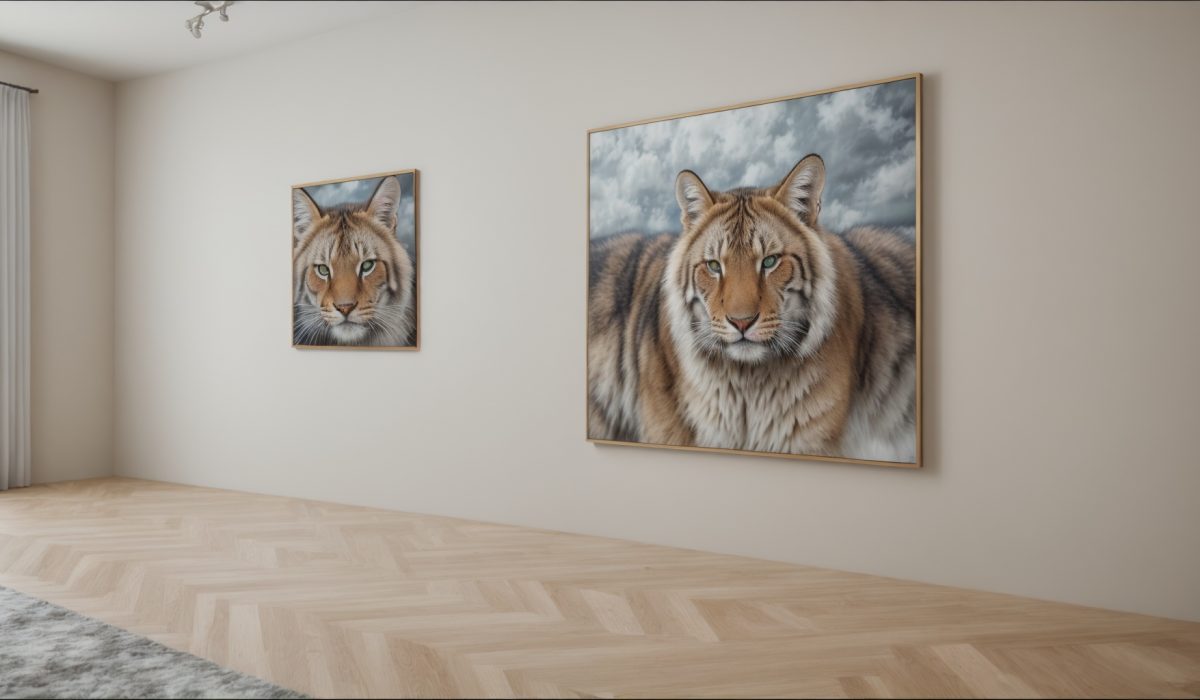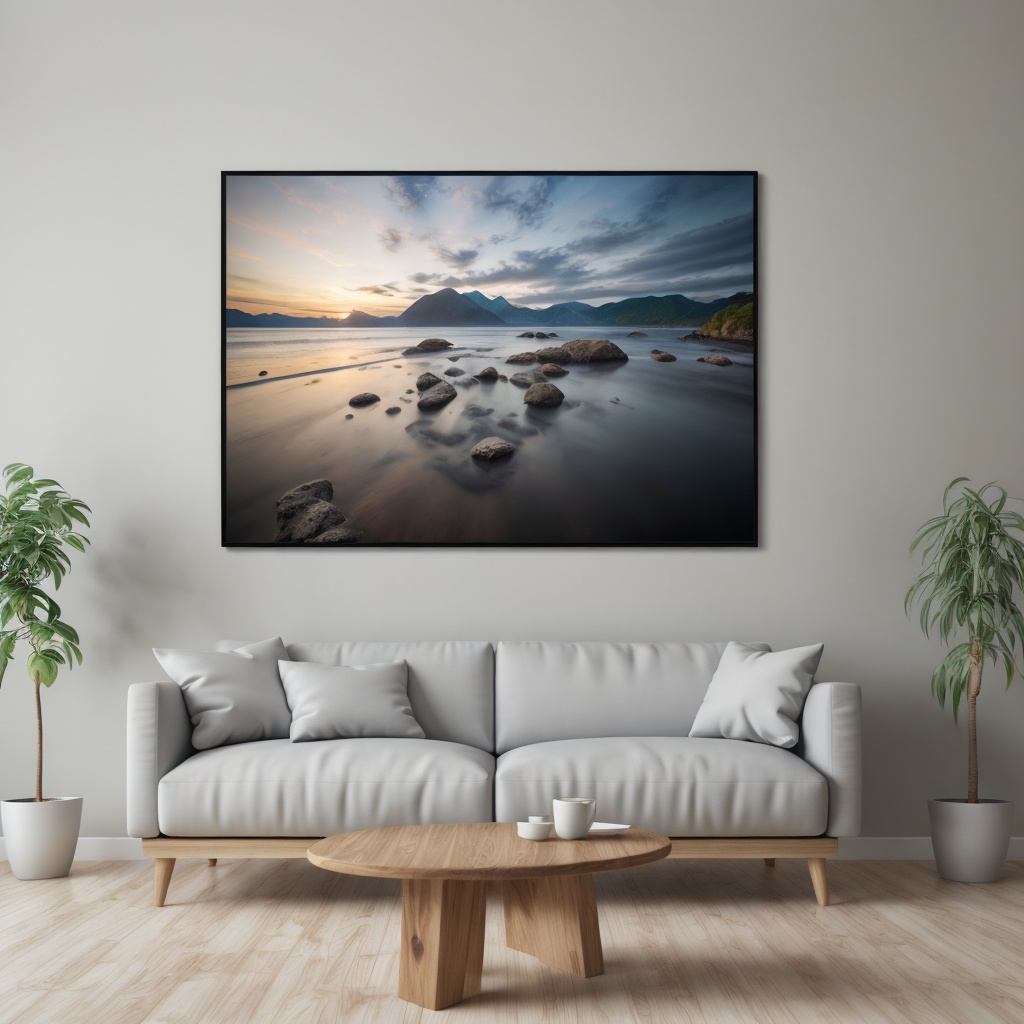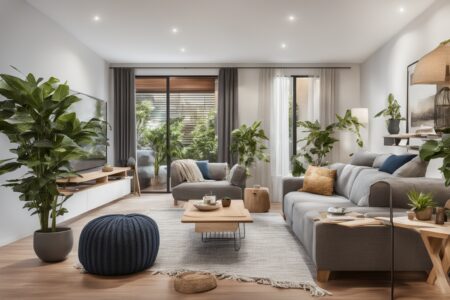Enhancing Spaces with Large Framed Artwork: A Guide

Welcome to our comprehensive guide on enhancing your living or working spaces with large framed artwork. Discover how selecting artwork that harmonises well in terms of size and scale can transform an area, lending it a renewed sense of volume and dynamism. Delve into diverse themes and styles that suit differing tastes and preferences and explore how the different colours can influence the mood and aesthetics of a room. We’ll guide you through various framing options that not only protect but also elevate the art piece itself. Additionally, we’ll discuss the best locations to showcase your large pieces to maximise their visual impact. Practical tips on how to hang and install these artworks will ensure they are displayed safely and to their best advantage. Beyond the installation, maintenance is crucial to preserve the art’s beauty and lifespan. As your collection grows, learn techniques for mixing different pieces to create a harmonious yet eclectic decor. By embracing these elements, you can optimise the artistic and stylistic impact of large framed artwork in your interiors.
CONTENT

Introduction to Large Framed Artwork
Understanding the Appeal
Large framed artwork serves not just as a decorative element but as a focal point that draws the eye and anchors the room. The sheer scale of large pieces can make a dramatic statement, transforming the feel and atmosphere of a space. Understanding the unique appeal and the transformative potential of large artwork can greatly assist in selecting pieces that will complement and enhance your environment.
History and Evolution
Throughout history, large framed artwork has been used to depict important events, portray significant figures, and convey cultural themes. Originally found in grand houses and public spaces, these artworks were symbols of status and taste. Today, they continue to be popular in both residential and commercial settings, reflecting both personal tastes and contemporary design trends.
Artistic Impact
The impact of large framed artwork is multifaceted, influencing both the aesthetic and the emotional ambiance of a room. It can set the tone, create depth, and introduce texture and colour in broad strokes that smaller pieces simply cannot achieve. Choosing the right artwork involves considering how it will complement the existing room aesthetics and how it will influence the viewer’s emotional response to the space.
Choosing the Right Size and Scale
When selecting large framed artwork, one of the foremost considerations should be the size and scale in relation to the room it’s intended for. A common mistake is choosing a piece that is either too large or too small for the available wall space. A good rule of thumb is that the artwork should fill approximately two-thirds to three-fourths of the available wall area. This ensures that the piece is proportional and enhances the overall composition without overwhelming the space.
Another aspect to consider is the ceiling height and room size. In rooms with high ceilings, taller artworks can complement the vertical space beautifully, whereas in more compact spaces with lower ceilings, a wider piece might be more appropriate. It’s also beneficial to think about the furniture and other elements in the room. Large artwork should integrate into the existing decor, rather than clash or disrupt the flow of the space. It should act as a counterpoint to the surrounding furniture, creating balance and harmony within the room.
Lastly, when determining the scale, it’s crucial to consider visual impact from different viewpoints. Evaluate how the artwork interacts with the room not only from the main entrance but also from other seating areas and viewpoints. The goal is for the artwork to be engaging from multiple perspectives, ensuring it enhances the space uniformly and contributes positively to the overall environment. This thoughtful placement maximises the piece’s aesthetic value and the spatial dynamics it introduces to an area.
Exploring Themes and Styles
Classic and Traditional Themes
Classic and traditional themes in large framed artwork often feature historical, religious, or nature motifs, employing a rich palette and detailed compositions to convey depth and luxury. These themes cater to more conservative tastes and are ideal for spaces that aim to evoke a sense of timelessness and sophistication. Incorporating such artwork can serve to elevate the formal quality of libraries, dining rooms, or any area where a refined aesthetic is desired.
Modern and Contemporary Styles
Modern and contemporary large framed artworks are typically characterised by minimalistic designs, abstract patterns, and bold colours. These styles complement modern interior decor and are perfect for making a strong, vibrant statement. Ideal for loft apartments, office spaces, or any room with a contemporary feel, these artworks help to break monotony and introduce a splash of creativity and cutting-edge appeal.
Eclectic and Mixed Media
Eclectic themes and mixed media artworks merge diverse elements from various styles and periods, creating a unique and eye-catching display. These artworks are particularly suited for individuals who appreciate a more personalised space reflective of their broad tastes. Whether it’s combining classic oil paintings with digital art or incorporating sculptural elements, these pieces can make a dramatic and intriguing statement in any space, sparking conversations and drawing interest.
The Impact of Colour in Large Artwork
The selection of colour in large framed artwork plays a critical role in setting the mood and atmosphere of a room. Vibrant, warm colours such as red, orange, and yellow can energise a space, making them ideal for areas like living rooms or areas where lively, dynamic activity occurs. On the other hand, cool colours like blue, green, and purple tend to evoke calmness and are perfect for creating a soothing environment in bedrooms or study spaces. The colour choice not only reflects personal aesthetics but also influences the psychological feel of the space.
Apart from affecting mood, the colours in large artworks can impact the perception of space size. Lighter colours tend to make a room feel more expansive and open, while darker colours can make large spaces feel more intimate and grounded. This visual manipulation is especially important in larger artworks, as their size means they have a significant impact on room dynamics. Selecting the right colours can optimise space utilisation, making them a powerful tool in interior design.
Moreover, colour can serve as a connective element within the interior design of a home or office. By choosing artwork with hues that echo other decorative elements or furnishing in the space, one can create a cohesive and harmonious design. Contrasting colours, when used deliberately, can create focal points that draw attention and make bold style statements. Through thoughtful selection of colour within large framed artwork, one can achieve a balance of both aesthetic beauty and functional design elements in any room.
Framing Options for Large Artwork
Traditional Wooden Frames
Traditional wooden frames are a timeless choice that offer a sense of warmth and classic beauty to large artworks. Available in a variety of stains from light to dark, and in styles ranging from simple to ornate, wooden frames can be paired with virtually any type of artwork. Additionally, the robust structure of wood suits larger pieces exceptionally well, providing strong support along with aesthetic appeal. For classical or rustic interiors, a well-chosen wooden frame can enhance the artwork and complement the room’s overall decor.
Modern Metal Frames
Metal frames, often made from aluminium or other lightweight materials, provide a sleek and contemporary look for large framed artwork. These frames are perfect for modern art styles and fit seamlessly into industrial or minimalist decor themes. Apart from their stylish appearance, metal frames are durable and resistant to warping, making them suitable for large pieces of artwork that demand a sturdy but visually light framing solution. Their clean lines and variety of finish options make metal frames a versatile choice for contemporary spaces.
Frameless Options
For a modern and unobtrusive look, going frameless is an increasingly popular choice for displaying large artwork. This method typically involves mounting the artwork on sturdy backing boards or using acrylic glass, which gives the impression that the art is floating off the wall. Frameless displays focus entirely on the artwork itself without any distraction from a surrounding frame, making them ideal for strikingly vibrant or visually complex pieces. This framing option is particularly favoured in modern, upscale environments where the art speaks loudly for itself.
Ideal Locations for Large Framed Artwork
Identifying the ideal location for large framed artwork in your home or office can profoundly enhance the space’s aesthetic and functional value. Entryways or foyers are prime spots for large artworks, as they set the tone for the entire home or office. Positioning a striking piece in these areas can make a bold statement and establish a welcoming ambiance right from the entrance. Similarly, high-traffic communal areas like living rooms or lounges benefit greatly from large artworks, which act as focal points and facilitate conversation among inhabitants and guests.
In a more contained setting such as a dining room or a conference room, large framed artwork can be used to create a sense of formality and importance. Here, the artwork often reflects the room’s purpose and can enhance the overall experience of meals or meetings, making them feel more elevated. Alternatively, placing large artwork in less expected places like kitchens or bathrooms can transform these utilitarian spaces into more engaging and thoughtfully designed environments, adding an element of surprise and creativity.
Lastly, consider the relationship between natural light and the artwork in prospective locations. Areas that receive ample natural daylight can bring out the vibrant colours and details of an artwork, making it look its best. However, it is crucial to ensure that artworks are not subjected to excessive direct sunlight which can cause fading. Assessing not just the wall space but also the quality of light it receives is essential when choosing the location for a large framed artwork, ensuring it is both protected and beautifully displayed.
Tips for Hanging and Installation
Assessing Wall Strength
Before hanging a large framed artwork, it is crucial to assess the strength and condition of the wall. Since large artworks typically weigh more, ensuring that your wall can support the weight is paramount. Use a stud finder to locate the studs in your wall as they provide a secure anchor point for heavy items. For walls without studs or those made of materials like plaster, using the appropriate wall anchors or toggle bolts can offer the necessary support to prevent damage and ensure the artwork is securely mounted.
Choosing the Right Hanging Hardware
Selecting the correct hanging hardware is vital for the safety and stability of large framed artwork. Heavy-duty hooks, D-rings, and wire are commonly used and reliable choices. The hardware should be proportionate to the weight and size of the frame. For pieces that are extremely heavy, consider using a French cleat system which distributes the weight evenly across a wider area of the wall. This not just enhances safety but also aids in maintaining the level and position of the artwork over time.
Placement and Alignment
Proper placement and alignment are key to maximising the visual impact of large framed artwork. As a general guideline, the centre of the artwork should be at eye-level, approximately 145-152 cm from the floor. This ensures that the artwork can be enjoyed comfortably from a standing or sitting position. Use a level to ensure the artwork is perfectly horizontal. For large pieces that dominate the wall, leave sufficient space around the artwork to prevent the space from feeling cramped, allowing the piece to stand out effectively.
Care and Maintenance of Framed Artwork
Caring for large framed artwork is essential to preserve its integrity and vibrancy over time. Regular dusting using a soft, dry microfiber cloth can prevent dust accumulation, which may eventually embed into the frame and the surface of the artwork. It’s advisable to avoid using cleaning chemicals or water on the artwork, as these can damage the materials. For glass-covered pieces, using a glass cleaner sprayed onto the cloth first rather than directly on the glass can prevent moisture from seeping into the frame and potentially harming the artwork.
In addition to routine dusting, it’s important to occasionally inspect your framed artwork for signs of wear or damage, such as changes in the colour of the artwork, moisture damage, or warping of the frame. Environmental factors play a significant role in the ageing of artwork. Therefore, it is crucial to keep the artwork away from direct sunlight, high humidity, or extreme temperatures, as these can cause fading, discolouration, or material degradation. If any signs of deterioration are noticed, consulting a professional conservator for appropriate restoration methods is recommended.
Lastly, for framed artworks lined with paper backing, it’s wise to periodically check the backing for any signs of insect infestation or mould growth. These issues can arise in regions with high humidity and can cause irreparable damage if left unaddressed. Making sure that the room where the artwork is displayed has adequate ventilation and stable temperature can help mitigate these risks. By taking these preventive steps, you secure not only the aesthetic appeal but also the long-term value of your large framed artwork, ensuring it can be enjoyed for many years to come.
Mixing Artwork in Home Decor
Creating a Gallery Wall
Creating a gallery wall is an effective way to mix different types of artwork in your home decor. Start by selecting a common element, such as colour scheme, frame style, or artwork theme, to bring cohesion to the collection. Arrange the artworks on the floor to experiment with layouts before committing to hanging them. Consider a mix of large and smaller pieces, with the larger artworks anchoring the arrangement. This dynamic setup allows for an expressive display that can be expanded or reconfigured over time.
Blending Styles and Periods
Integrating artwork from various styles and periods can add depth and interest to your home decor. When mixing modern art with classical pieces, pay attention to balance and placement to ensure that no single piece overpowers another. Use colour and texture as linking elements to create harmony; for instance, matching a vintage oil painting with contemporary graphic prints that share similar hues. Successfully blending diverse artworks welcomes a sophisticated, curated look that reflects your personal taste and history.
Incorporating Sculptural and 3D Elements
Adding sculptural or three-dimensional artwork to your decor can enhance the textural interplay within a space. These pieces can be strategically placed to break the monotony of two-dimensional artworks. Consider the interplay of shadows and light that these pieces bring, positioning them where they can be appreciated from different angles. Combining these with traditional framed artwork invites a tactile exploration and brings a lively dimensionality to any room, making the space more engaging and visually intriguing.
Conclusion: Maximising the Impact of Large Framed Artwork
Maximising the impact of large framed artwork goes beyond simply choosing a piece and placing it within a space. It involves thoughtful consideration of how each artwork interacts with the elements around it, from furniture and architectural details to the ambient lighting. To truly enhance a space, consider the visual balance. Large artworks should not overpower but rather complement other visual aspects of the room, creating a cohesive aesthetic that feels harmonious and purposefully designed.
Incorporating large framed artwork also presents an opportunity to express personal style and create a narrative within your home or workspace. Whether it’s a bold, abstract piece that sparks imagination or a serene landscape that promotes calm, each artwork can significantly influence the atmosphere of a room. It is vital to select pieces that resonate on a personal level, as these will not only become focal points but also enrich your daily living or working environment.
Furthermore, the versatility of large framed artwork as a design element allows for flexibility in decor styling over time. As tastes and trends evolve, so too can the arrangement and context of your artwork. By updating frames, relocating pieces, or adding new art to existing collections, you can keep your space dynamic and reflective of current aesthetics without making extensive alterations. This adaptability makes large framed artwork a worthwhile and enduring investment in any interior design scheme.






